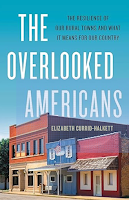 |
Willie Nelson singing at the first Farm Aid concert in 1985.
(Wayne Walldogs photo via Successful Farming) |
Murals in Wayne County, Iowa, stand as a testament to the region's dynamic and resilient history. "Wayne County, a part of the Mormon Trail, where Brigham Young led his followers from Illinois to Utah in 1846, is also known for its excellent hunting opportunities, large Amish community, and well-appointed historical museum,"
reports Lisa Prater Froust of
Successful Farming. "Last year, these historical events and figures were vividly brought to life in 16 murals painted during the five-day Wayne County Walldogs Festival." Not sure what 'walldog' is? Click
here.
 |
The Midwestern United States
(Wikipedia map, from Census Bureau data) |
Think you're a Midwesterner? For most residents, the answer depends on geography, but some people have other ideas. "Everyone knows places such as Ohio and Minnesota are solidly in the Midwest. But a recent poll finds that the Midwest is more a state of mind than just a place you can point to on a map,"
report Ben Kesling and Jennifer Levitz of
The Wall Street Journal. "People from Colorado (42%), Oklahoma (66%) and even Wyoming (54%) think they live in the Midwest. . . . Some locals are baffled: 'Who ARE you people?'"
 |
Pluto was demoted to one of dozens of dwarf
planets. (NASA photo via Nat Geo) |
In 1930, a farm boy turned astronomer from Streator, Illinois, Clyde William Tombaug, discovered Pluto, which was designated our solar system's ninth planet, but then in 2006, Pluto got demoted. "Mike Brown,
CalTech professor of astronomy and author of
How I Killed Pluto and Why it Had it Coming, crashed the party and took away Pluto's planetary classification,"
reports Eric Alt of
National Geographic. "Ever since the worlds of science and pop culture have debated Pluto's fate. . . . the matter seems far from settled."
Some news sources say the U.S. economy is recovering from the dark days
of the pandemic, with most measures reporting a healthy rebound despite
inflation's hold on grocery and housing costs. That's one picture. Talk
to a local pawnbroker, and you'll hear a different report. "Accumulating
pawnshop inventory means fewer buyers than sellers – a sign that for
the lowest-income Americans, times remain tough,"
reports Lauren Villagran of
USA Today.
"Some Americans – people with retirement plans, savings and stock
holdings – may gripe about inflation and the economy, but they're doing
all right. Others are surviving pawn to pawn."
 |
Location of Mikanda in Jackson
County, Illinois. (Wikipedia map)
|
|
The U.S. eclipse capital is the unassuming southern Illinois town of
Mikanda, Illinois, pop. 500. It has been "blessed by the cosmos for the
second time in under 10 years,"
reports Hunter
Bassler of
KSDK in St. Louis, Missouri. "Mikanda is the exact
intersection for both the 2017 and 2024 eclipses, an astronomical wonder
that rarely ever happens in such a short time span,
according to NASA. . . . Village officials are preparing for bigger crowds this year."
 |
Rainbow over Cheesebox Butte. Cheesebox Canyon is a popular Bear Ears
hiking trail.
(Photo by Stephen Trimble, Writers on the Range) |
Without knowing the region's history, Bear Ears National Monument evokes thoughts of strength, softness, and beauty. Dive deeper into the story of this 1.36 million-acre site in southeast Utah, and a timeline of battles, historical power dynamics and unresolved conflict emerges. "The political tussle over this stunning expanse of red rock canyons exemplifies all the cultural dissonance in the rural West,"
writes Stephen Trimble in his opinion for
Writers on the Range. "White residents never envisioned challenges to their political power. But in 2009, the feds came down hard on generations of casual pothunting by local white families. Then, after a century of oppressing their Indigenous neighbors, lawsuits strengthened Native voting rights."

















